Books
Books
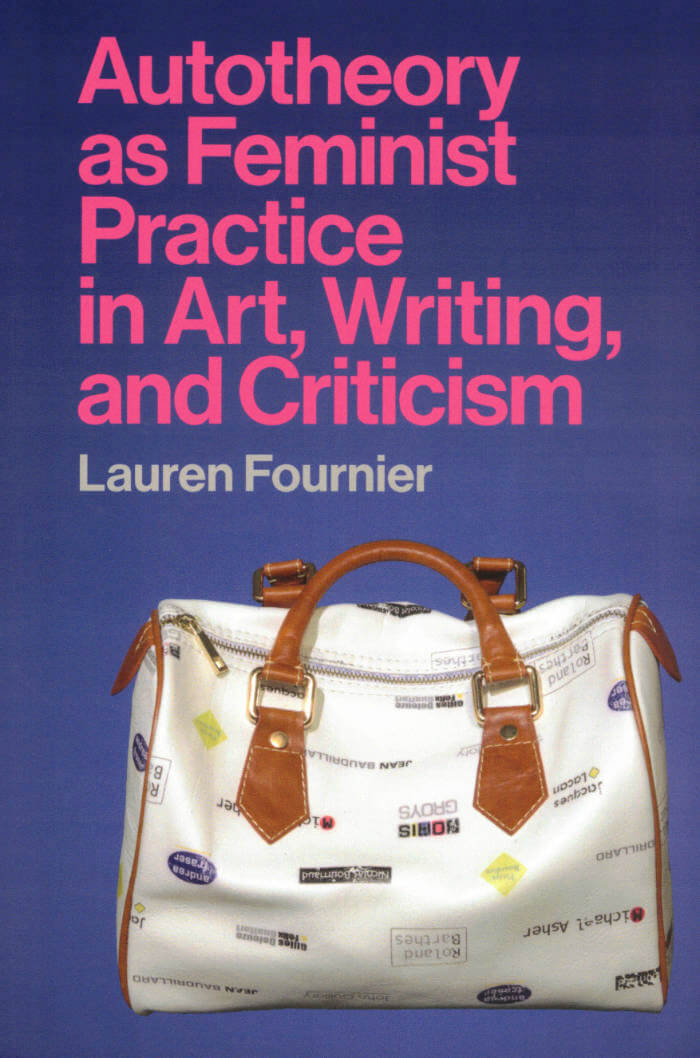
Autotheory as Feminist Practice in Art, Writing, and Criticism
Autotheory—the commingling of theory and philosophy with autobiography—as a mode of critical artistic practice indebted to feminist writing and activism.
In the 2010s, the term “autotheory” began to trend in literary spheres, where it was used to describe books in which memoir and autobiography fused with theory and philosophy. In this book, Lauren Fournier extends the meaning of the term, applying it to other disciplines and practices. Fournier provides a long-awaited account of autotheory, situating it as a mode of contemporary, post-1960s artistic practice that is indebted to feminist writing, art, and activism. Investigating a series of works by writers and artists including Chris Kraus and Adrian Piper, she considers the politics, aesthetics, and ethics of autotheory.
Fournier argues that the autotheoretical turn signals the tenuousness of illusory separations between art and life, theory and practice, work and the self—divisions long blurred by feminist artists and scholars. Autotheory challenges dominant approaches to philosophizing and theorizing while enabling new ways for artists and writers to reflect on their lives. She argues that Kraus's 1997 I Love Dick marked the emergence of a newly performative, post-memoir “I”; recasts Piper's 1971 performance work Food for the Spirit as autotheory; considers autotheory as critique; examines practices of citation in autotheoretical work, including Maggie Nelson's The Argonauts; and looks at the aesthetics and ethics of disclosure and exposure, exploring the nuanced feminist politics around autotheoretical practices and such movements as #MeToo. Fournier formulates autotheory as a reflexive movement, connecting thinking, making art, living, and theorizing.

How to Become Irrésistibles
How to become Irrésistibles est une édition de l'école supérieure des beaux-arts de Bordeaux réalisée avec la maison d'édition How to Become.
Cette édition est née de l'énergie d'un groupe d'autrices étudiantes de l'école des beaux arts de Bordeaux. Elles (car il s'agit d'une majorité de femmes) se rassemblent dans les séminaires Irrésistibles – briser les cases (art-femmes-territoires) dirigés par Marie Legros, artiste et professeure. Ce séminaire a été créé par cette dernière en 2016 afin d'encourager les pratiques féministes dans l'écriture. Qu'est-ce que c'est ? Des façons autres d'écrire le genre (l'identité) et les genres (littéraires), la langue (nationale) et de faire entrer du commun dans l'écriture (en arrêtant d'en exclure les femmes, les homos, les personnes racisées, les prolos). Les étudiantes qui participent à ce séminaire, issues de nationalités différentes, s'en sont saisis pour tordre la généalogie poétique franco-française masculiniste. L'autrice et éditrice sabrina soyer (éditions How to become), invitée à prendre part aux recherches dans ce séminaire, a coordonné cet ouvrage en l'axant sur des échanges de traduction entre autrices et l'usage du français comme langue étrangère. Le livre explore – c'est à dire donne de la valeur à – différentes formes de contacts entre auteurices : traductions, réponses adressées, écriture sous influence ou fan fiction... Chaque langue et voix se tisse en écho à une autre, pas de poèmes isolés, un grand texte comme un grand corps amassé par rebonds et frottements.
Avec : Hani Yikyung Han, Nayun Eom, Charles Dauphinot, Layan Qarain, Viktoria Oresho, Samuel R. Delany, Seobin Park, Jie Liang, Rami Karim, Yu-Wen Wang, Ching-Chuan Kuo, Mélanie Blaison, Barbara Sirieix, sabrina soyer, Yan Tong Liu, Jessica Guez Karen Johanns, Marie Legros M, Esther Sauzet, Mira Mattar.

What Makes an Assembly? – Stories, Experiments, and Inquiries
Laurent Jeanpierre, Anne Davidian
A crossdisciplinary inquiry into the practices and forms of assembly making, through multiple times and geographies.
Assemblies are ancestral, transcultural ways of coming together as a community. Over the past decades, multiple social movements have reappropriated these forms of collective organisation as a prominent component of political struggle, to defend radical visions of democracy. At the same time, governments across the globe have sought to reframe public deliberation as a response to the failures of representative democracy.
How can we analyze this double movement, and could assemblies of equals once again offer possibilities to reimagine and renew the ways politics is practiced? To address these questions, we need to move beyond simply asking what assemblies can do, and instead examine how they are made. This means departing from the shores of a speculative, deliberative ideal and restoring attention to both their diversity of forms, and their capacities to perform, deform, and transform.
Bringing together accounts written by those who practice assemblies, and contributions from artists, activists, historians, philosophers, and social scientists, as well as three architectural experiments that attempt to imagine models for a future assembly, the book proposes a critical inquiry into the potential of assemblies to shape political subjects. From assemblies in Indigenous territories of Brazil to those of the Yellow Vests in France, from medieval communes to street parliaments in Africa, from citizens' assemblies set up by public authorities to practices forged from emancipatory traditions, What Makes An Assembly? examines the tensions that exist in all assemblies between the need for form and the danger of formalization; between the scripts, rituals, and architectural settings from which they derive, and their capacity to erupt and emerge anew.
Contributions by Ayreen Anastas, Andreas Angelidakis, Hans Asenbaum, Frédérique Aït-Touati, Richard Banégas, Sandra Benites, Jean Godefroy Bidima, Patrick Boucheron, Florence Brisset-Foucault, Manuel Callahan, François Cooren, Armando Cutolo, Pascale Dufour, Ben Eersels, Tallulah Frappier, Rene Gabri, Delphine Gardey, Alana Gerecke, Andrés Jaque/Office for Political Innovation, Laurent Jeanpierre, Pablo Lafuente, Laura Levin, Stacey Liou, Catherine Malabou, Charlotte Malterre-Barthes, Florian Malzacher, Piersandra Di Matteo, Markus Miessen, raumlabor, Philippe Urfalino, Yellow Vests, Aleksandra Wasilkowska, Ana Terra Yawalapiti.

Spike #73 – Vulnerability
To live means to be exposed, to be vulnerable, and seek safety. But what if we give up control and don't try to cover the wounds any more? Could we ultimately transcend to openness? This is one of the core questions Spike asks in its autumn issue. From the imperfections of the body to automated text generators, from poor images to pop stars. Spike #73 is about art's soft underbelly, why writing in first person is a risk, why humans fear each other, and grappling with grief, paranoia, and intoxication. Let's find out what happens if we take off our shells.
With contributions by: McKenzie Wark, Marlene Dumas, Tosh Basco, James Richards, Raimundas Malašauskas, Joanna Walsh, Kandis Williams, Mire Lee, Gustav Metzger, Rob Horning, Tea Hacic-Vlahovic, Constance Debré, Luca Lo Pinto, Simone Forti...

Sint-Lucas School of Arts Antwerp
TYPP #8 — Blind Spot
The human eye is designed with a flaw that is common to all other vertebrates: we have a blind spot, the punctum caecum, a small patch on the inside of our boisterous orbs of vision with no photoreceptors. A blind spot can also be psychological or social. We tend to be biased towards situations or people we cannot fully ‘see through’. How can we enlighten our blind spots? What kind of artistic practices can inspire new readings of history, art, music, or even politics?
With contributions by Bent Vande Sompele, Pierre-Antoine Vettorello & Stella Nyanchama Okemwa, and Haseeb Ahmed. Design by Ward Heirwegh. Chief Editor: Zeynep Kubat. Editorial Board: Mekhitar Garabedian, Caroline Dumalin, Saskia Van der Gucht, Paul Hendrikse.

nY49 — trans*
Sven Van den Bossche, Hans Demeyer and 1 more
“Een thematisch nummer maken over trans*esthetiek riskeert trans*heid meteen als iets aparts te signaleren, als iets wat niet simpelweg kan zijn; hoe stel je ‘gewoon’ een special issue samen?”
Het nummer werd samengesteld door Dagmar Bosma, Hans Demeyer en Sven Van den Bossche.
Met bijdrages van: Ada M. Patterson, Camille Pier, Sven Van den Bossche, Alara Adilow, Nour Helou & Afrang Nordlöf Malekian, Mariken Heitman, misha verdonck, Dagmar Bosma, Hans Demeyer, Torrey Peters, Kato Trieu, Valentijn Hoogenkamp, Romeo Roxman Gatt, Lieks Hettinga, Kalib Batta, Kopano Maroga, Hannah Chris Lomans en Nele Buyst.
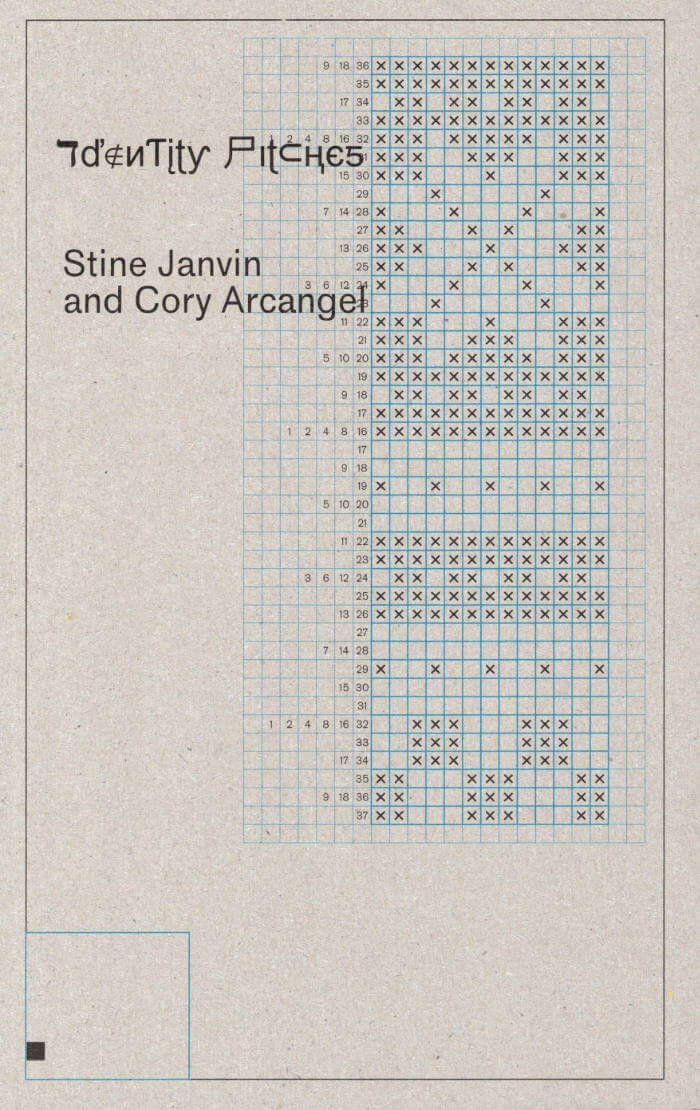
Identity Pitches
A collaborative artist's book of musical scores based on Norwegian knitting patterns.
For Identity Pitches, artists Cory Arcangel (born 1978) and Stine Janvin (born 1985) have composed conceptual music scores based on the knitting patterns for traditional Norwegian sweaters known as Lusekofte. Utilizing three of the most popular designs (Setesdal, Fana and the eight-petal rose of Selbu) of this ubiquitous garment, Janvin creates scores for both solo and ensemble performers by mapping the knitting patterns onto the harmonic and subharmonic series and integrating the tuning principles of traditional Norwegian instruments. These scores are further manipulated by Arcangel using a custom "deep-fried" coding script to create a series of image glitches.
A foreword and an interview between the two artists, both based in Stavanger, Norway, provide context for the work, delving into the history of Norwegian folk music tunings and the Lusekofte sweater and their intersection with the cultural identity of the country over the last millennium.

ABÉCÉDAIRE
“I wrote (more or less, for promises are always hard to keep, even those made to oneself ) for five days a week for a year. I wrote no more than a page, or rather, I wrote only for the length of the analytic hour, fifty minutes (though I also practiced the variable session at times)… I followed Freud’s model of train travel for his theory of free association, acting ‘as though, for instance, [you were] a traveller sitting next to the window of a railway carriage and describing to someone inside the carriage the changing views which [you] see outside’. As for my characters, many of their names begin with A. Some of these women exist or existed, others are from fiction, or write fiction. Some are friends or acquaintances. None are credited but a keen reader could recognise many of them. I invented nothing. I am the aleph.”

Robida magazine n. 8 — Isola Otok Island
Robida 8 is imagined and organised as a journey, that can explore aspects of island life along a narrative thread, as if developing the structure of an epic voyage: from the Embarkation – where introductory perspectives on islands are offered –, then into the Departure – which considers the islands from afar, as conceptual entities –, through the Tempest – representative of the turmoils and movement that island stand for –, passing from the Strandedness – where the island coincides with stillness –, to finally approach the Homecoming, and the island as repository of collective as well as personal memory. The aim is for this journey to enrich our understanding of islands, as fertile ground for exploring what it means to inhabit a place.
Robida is a multilingual cultural magazine. It is published yearly by the association Robida which is based in Topolò, a village of twenty inhabitants on the border between Italy and Slovenia. The magazine explores different topics – such as abandonment, silence, the relation between domesticity and wildness, forest etc. – which are connected to the place where the magazine comes to life, namely Topolò. The eight issue reflects on the island which is explored through essays, photography, art projects, academic texts, interviews and personal written by authors from all over the world, from Argentina to Poland, from US to Slovenia.
Trilingual edition: Italian / Slovenian / English
Editorial board: Dora Ciccone, Maria Moschioni, Elena Rucli, Vida Rucli, Laura Savina, Aljaž Škrlep, Janja Šušnjar.
Contributors: Adele Dipasquale and Cristina Lavosi, Adriana Gallo, Agnieszka Dragon, Ajda Bračič, Alessandro Simone and Francesca Cassi, Alice Pedroletti and Alessandra Saviotti, Ana Escariz Péres, Anna Bierler, Anne Kathrin Müller, Antônio Frederico Lasalvia, Brechje Krah, Camilla Isola, Camilla Marrese and Gabriele Chiapparini, Chiara Alexandra Young, Chiara Dorbolò, Constanze Flamme, Deborah Mora, Dora Ciccone, Elena Rucli, Federica Carlotta Lai, Gabriele Zagaglia and Fernanda Villari, Giacomo Bianco, Giampaolo De Pietro, Giuditta Trani, Greta Biondi and Vittoria Rubini, Guglielmo Giomi, Haydée Touitou, Igor Martinig, Kaja Rakušček, Katrina Pelikan Bašelj, Laura Savina, Léna Lewis-King, Livia Galtieri, Ludivine Gragy, Ludovica Battista, make LARMO, Mara-Luna Brandt Corstius, Marcos Beccari, Margherita Falqui, Marie Ilse Bourlanges, Marie Kerkeling, Marta Marini and Cecilia Bima, Marta Marini and Francesca Matracchi, Mauro Tosarelli, Melissa Carnemolla, Mercedes Villalba, Ola Korbańska, Olya Korsun, Opher Thomson, Rachele Daminelli, Romane Bourgeois, Silvia Sfiligiotti, Siria Falleroni, Stefano Conti, Tanja Marmai, Titta C. Raccagni, Tymon Hogenelst and Jesse van der Ploeg, Valerija Intihar, Vidya Narine, William Belloche.

The Letters of Douglas Oliver and J. H. Prynne
Douglas Oliver (1937–2000) and J. H. Prynne (b. 1936) are two of the most original and ambitious poets of the contemporary era. Eschewing the conservativism of mainstream postwar British verse and embracing influences from America and Europe, each developed their craft through continuous correspondence and exchange as part of the febrile scene of poetical community and contestation that emerged in Cambridge in the 1960s. Their works over the following decades exhibit frequent shifts in form and style, from Prynne’s radical transformation and dispersal of the lyric tradition to Oliver’s adaptation of dream visions and medieval-inspired verse satires.
Their letters are a record of both the high stakes and playful experiments that constitute the writing lives of two singular poets determined not just to engage with modern political and social life during decades of crisis and upheaval, but to contribute through the circulation and publication of poetry to what Oliver calls “a community of political ethic.” Over the course of more than thirty years of friendship and mutual appreciation, the motivations for, and consequences of, their poems are constantly worked through, tested out, evaluated, and contradicted, always with a view to what the poetry means for the other, for the poetical communities they inhabit, and for the life of poetry itself.
This volume collects for the first time the majority of Oliver and Prynne’s correspondence, allowing new insights into the literary, political, and historical contexts of their lives and writing. An introduction, notes, and appendices provide a scholarly apparatus to situate Oliver and Prynne among the poets and publishers with whom they worked and socialized, and to identify and expand upon their frequent references to an enormous range of source material and reading matter.
“The correspondence between J. H. Prynne and Douglas Oliver is gripping and illuminating, brilliantly edited and completely absorbing. Two great poetic intelligences respond to each other’s work and to the society around them, thinking through the issues at stake in their poetic practice, their differences in approach, the different worlds they inhabit, their shared commitment to writing poetry and their admiration of each other’s work. The letters, complex as their matter can be, repay repeated reading; taken together, over a period of 33 years, they chart the context and creation of some of the most significant work in late twentieth-century poetry. This is an utterly engaging volume, and should be read by anybody interested in poetry and its place in the contemporary world.”—Ian Patterson
“For writers who welcome each other as peers, the exchange of letters is the spontaneous moment of exposure, the drawing out of selves. It is thinking in mutuality. In this thoughtfully edited and carefully, even beautifully, presented correspondence between Douglas Oliver and J. H. Prynne, two of the preeminent poets of the ‘British Poetry Revival’ of the post-World War II generations, we witness two writers of immense gifts thinking with each other, coming alive to thought and, ultimately, a shared world or community of wish. There is life, there is death; there is grief, there is anger – and love – but always there is a seeking, an attempt to arrive at a language for our worlds. Henceforth, one cannot imagine reading the work of either Oliver or Prynne without this correspondence and all that it offers in openings onto what Oliver himself saw as ‘the poet’s full performance [which] is the whole life’s work.’ It is a glimpse into an athanor of poetic creation.”—Michael Stone-Richards
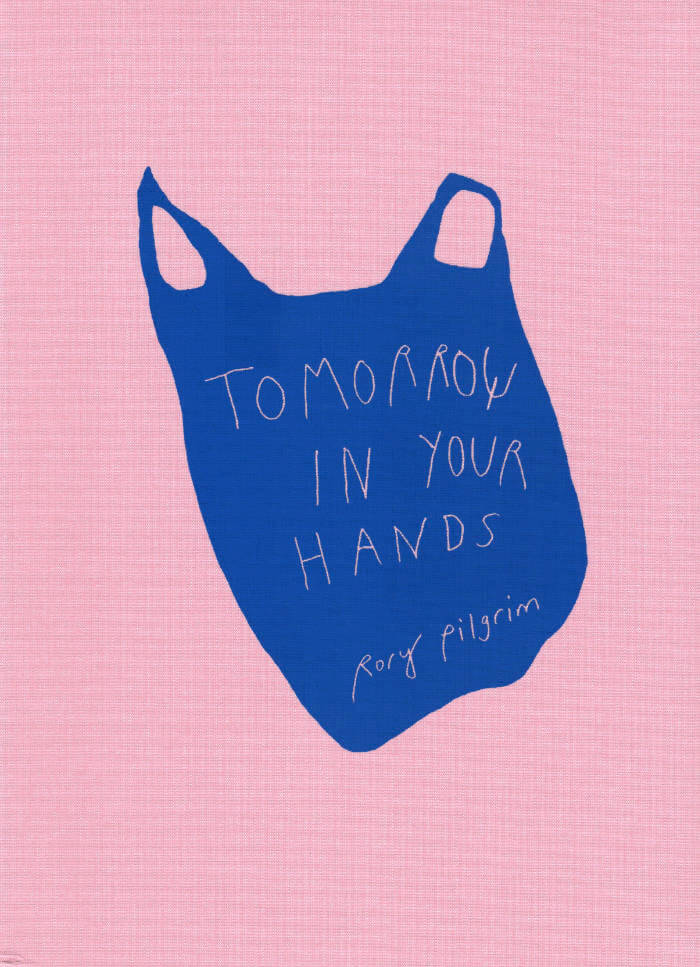
Tomorrow in Your Hands
Rory Pilgrim presents their first catalogue, bringing together their multifaceted practice as a filmmaker, composer, and more. Sharing work produced since 2008, this lovingly made book designed by Modern Activity includes sketchbooks, scores, song lyrics, and poetry. It is published on the occasion of the exhibitions Where The Tide Takes Us, Kunstverein Braunschweig, Germany, and Radio Ballads, Serpentine Gallery, London.
Rory Pilgrim (born 1988 in Bristol) works in a wide range of media including songwriting, composing music, film, music video, text, drawing and live performances. Centred on emancipatory concerns, Pilgrim aims to challenge the nature of how we come together, speak, listen and strive for social change through sharing and voicing personal experience. Strongly influenced by the origins of activist, feminist and socially engaged art, Pilgrim works with others through a different methods of dialogue, collaboration and workshops. In an age of increasing technological interaction, Rory Pilgrim's work creates connections between activism, spirituality, music and how we form community locally and globally from both beyond and behind our screens.
Edited by Rory Pilgrim, Jule Hillgärtner, Nele Kaczmarek, Zsa-Zsa Eyck, Matthew Appleton.
Texts by Jerry Brady, Jule Hillgärtner, Nele Kaczmarek, Human Poney, Louwrien Wijers.
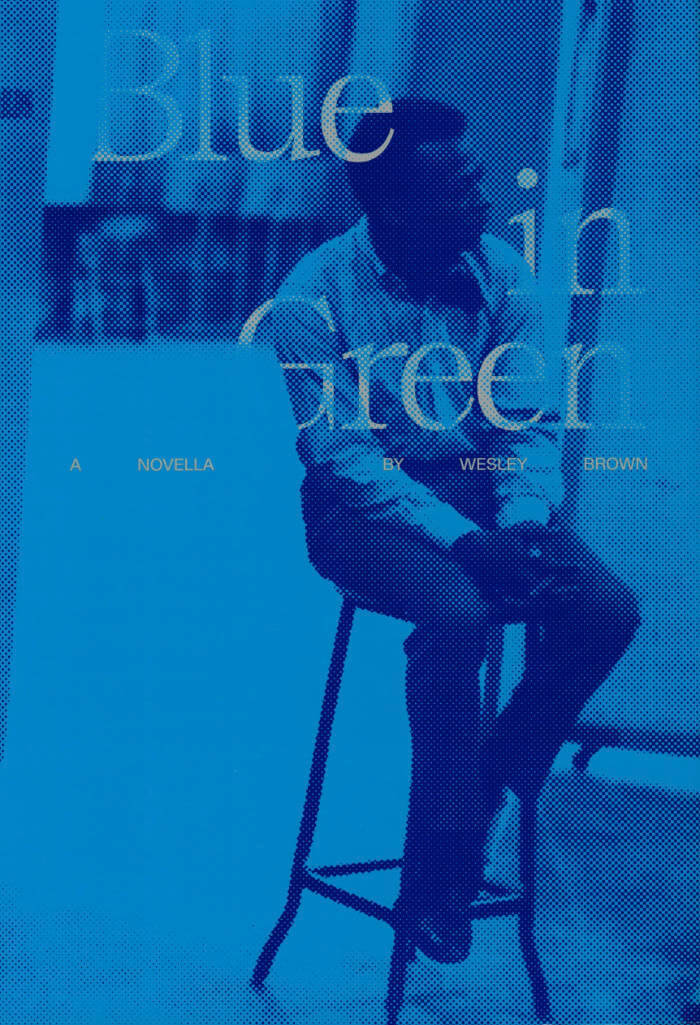
Blue in Green
Wesley Brown narrates the day when trumpeter Miles Davis was assaulted by the New York Police Department. A dramatic and humorous story, told from multiple perspectives including that of Frances Taylor, Davis's wife, and the musicians in Davis's bands: a timely meditation on the psychological impact of police brutality, through the lens of a day in the life of Miles Davis.
The latest work from the veteran novelist called "one hell of a writer" by James Baldwin and "wonderfully wry" by Donald Barthelme, Blue in Green narrates one evening in August 1959, when, mere weeks after the release of his landmark album Kind of Blue, Miles Davis is assaulted by a member of the New York City Police Department outside of Birdland. In the aftermath, we enter the strained relationship between Davis and the woman he will soon marry, Frances Taylor, whom he has recently pressured into ending her run as a performer on Broadway and retiring from modern dance and ballet altogether. Frances, who is increasingly subject to Davis's temper—fueled by both his professional envy and substance abuse— reckons with her disciplined upbringing, and, through a fateful meeting with Lena Horne, the conflicting demands of motherhood and artistic vocation. Meanwhile, blowing off steam from his beating, Miles speeds across Manhattan in his sports car. Racing alongside him are recollections of a stony, young John Coltrane, a combative Charlie Parker, and the stilted world of the Black middle class he's left behind.
"Wesley Brown is a writer's writer. His dialog in Blue in Green is remarkable. He knows the varieties of the American language in and out. We get fascinating portraits of Dizzy Gillespie, Thelonious Monk, Billie Holiday, Clark Terry, Lena Horne, Katherine Dunham, Eartha Kitt, and others. An insider named Freeloader provides comic relief. Before the salespersons dictated trends in Black literature, a major publisher would have published this book. Thanks to Blank Forms and other midsize presses, the Black literary tradition, whose fictional standards were set by Brooks, Wright, Himes, Polite, Bambara, and others, is alive." — Ishmael Reed
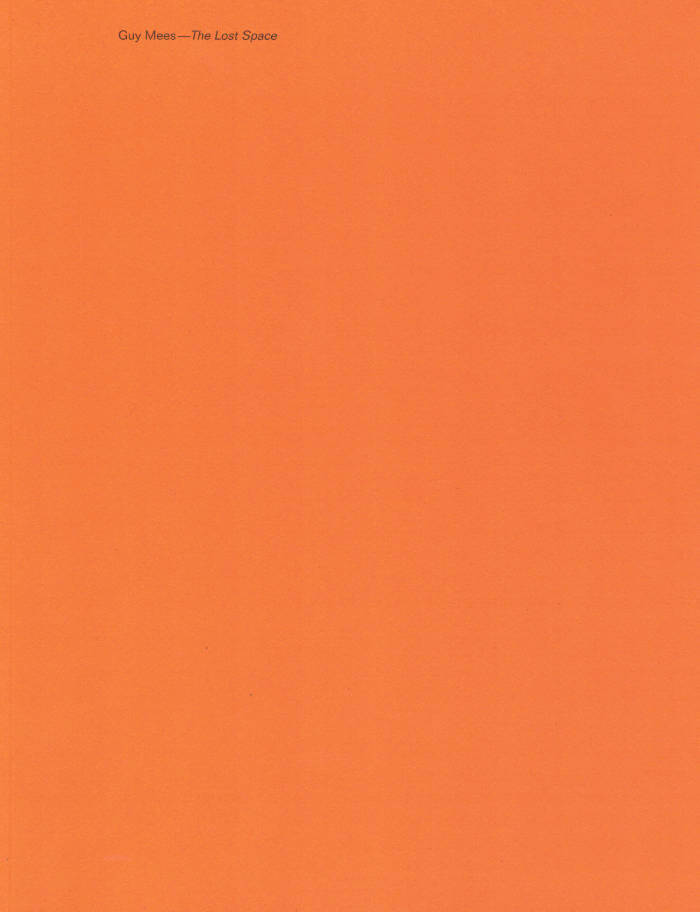
The Lost Space
Publication devoted to the only statement the Belgian artist has ever published about his own work.
Those familiar with Guy Mees know that he used the enigmatic title Lost Space to describe two major bodies of work, distinct in origin and form, and separated by a gap of more than twenty years: the geometric objects and panels covered in lace created in the 1960s, and the works he started producing in the 1980s featuring colour paper cutouts pinned to walls. This publication is dedicated to a lesser-known chapter in this story: the writing process of a short text entitled, likewise,The Lost Space. An ambiguous manifesto for Mees' work, the text went through a number of revisions, with Mees contributing suggestions, but never authoring it himself. This book reproduces eight extant versions of the text for the first time, in facsimile and typographic transcription as Richard Hamilton did with the Large Glass notes of Marcel Duchamp.
Published on the occasion of Guy Mees at MU.ZEE, Ostende, in 2019.
Limited edition of 350 copies.
Guy Mees (1935-2003) is a Belgian artist whose oeuvre encompasses photographs, videos, sculptures, and fragile works on paper that combine formal rigor with delicacy and a conceptual approach. A leading figure of the Belgian avant-garde, Mees left behind an outstanding body of work that transgresses geometric abstraction, Minimalism, Conceptualism, and applied arts.
Edited by Lilou Vidal.
Graphic design: Joris Kritis.
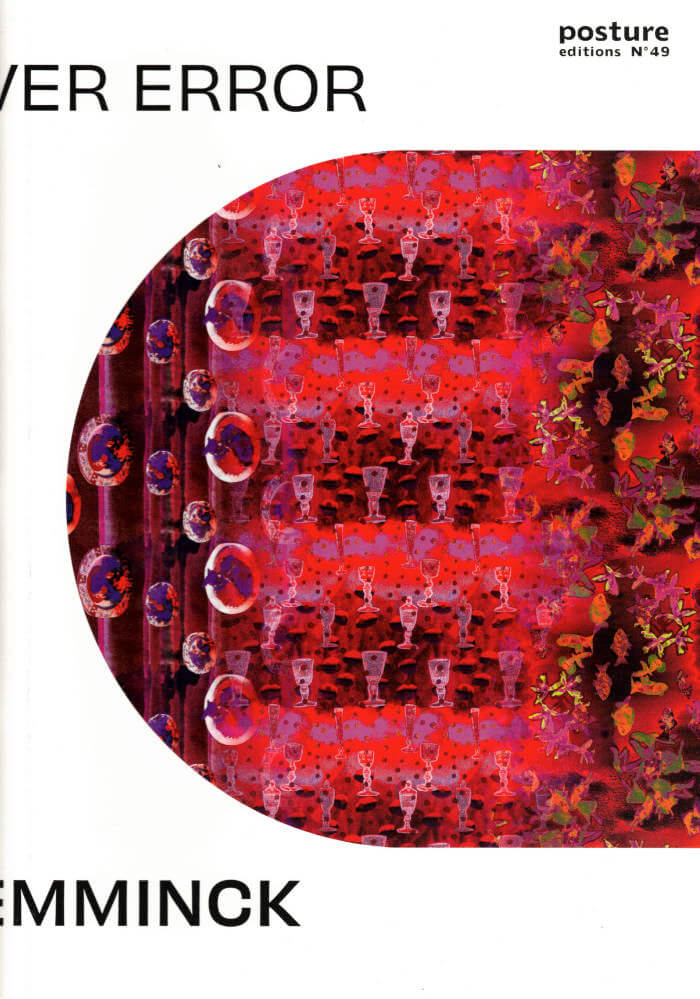
Screensaver Error
Nº 49 / October 2022
In her work, Lisa Vlaemminck explores the boundaries of painting, creating an exciting, vibrating and disorienting universe. In her images, she questions very classical phenomena in painting, such as the landscape and the still life, by freezing them behind semi-transparent layers of paint. We catch a glimpse that feels familiar, but soon find that nothing is what it seems. Vlaemminck’s work oscillates between the microscopic and the interstellar, as well as the amorphous spaces in between. Image, material, shape, texture and form mutate into compositional playgrounds floating in a newly created universe where different laws and rules apply.
The book “Screensaver Error” is conceived as a symmetrical, folded stack of sheets with images of Lisa’s paintings and collages.
At the heart of the book is the sixty-metre long, worm-shaped textile sculpture, which runs like a stream through the book for many pages.
Dominique De Groen wrote an electrically charged shimmering poem tailored to the work. The introductory text was written by Simon Delobel.
In KIOSK, Lisa Vlaemminck presents a series of new paintings and a sixty-metre long textile sculpture that will occupy the various exhibition spaces. For the design of the fabric, Lisa worked patterns that form a long colour gradient.
At the end of the exhibition, the sculpture, Meat A Morph Hose, will be cut into 35 separate, new sculptures that will be offered as artworks at € 350 each. Each work is a part of the colour gradient and has a unique print. The proceeds will finance the book. Details: Printed cotton, latex spaghetti filling, the ends are closed with climbing rope
40 cm diameter x 130cmA signed copy of the book will also be delivered together with the work.
The sculptures can be collected from KIOSK at the book-launch: Sat. 26 November
The artist is reprented by gallery rodolphe janssen

sawing a plank is like going for a walk
With texts by Phillip Van den Bossche, Filarowska and a conversation between Eva Wittocx and the artist (NL/EN)
Nº 48 / October 2022
sawing a plank is like going for a walk by Kato Six (b. 1986) is published on the occasion of Kato’s solo exhibition at M Leuven this autumn. This book encapsulates 10 years of her quest as an artist.
The work of Kato Six (b. 1986) balances between abstract and figurative art. She works on different themes which she develops into series or ensembles. Architecture, design, domesticity and utensils all act as important references. Starting there, she uses recognisable and everyday materials such as MDF, stone, plastic or textiles.
Kato wants to question certain affinities and let the viewer look at familiar objects or images from a different perspective. As a viewer, you feel connected to the object or image but the actual meaning or function no longer applies.
Some of my works refer to the domestic, especially the most recent ones, such as ‘Carpet Beater Carpet’ and ‘Striped Knitwear’. The invisible work done by “housewives”, but also by workers or maintenance staff, is certainly one of the themes addressed in ‘Carpet Beater Carpet’. The above works are textile works, created with so-called “soft skills”. In the arts, these “soft skills” are often attributed to female artists — women often being assigned a certain medium.
Kato Six in conversation with Eva Wittocx in “sawing a plank is like going for a walk”

Pathetic Literature
A unique collection composed by the award-winning poet and writer, a global anthology of pieces from lesser-known classics by luminaries like Franz Kafka, Samuel R. Delany, and Gwendolyn Brooks to up-and-coming writers that examine pathos and feeling, giving a well-timed rehab to the word "pathetic"
"Literature is pathetic." So claims Eileen Myles in their bold and bracing introduction to Pathetic Literature, an exuberant collection of pieces ranging from poetry to theater to prose to something in between, all of which explore those so-called "pathetic" or sensitive feelings around which lives are built and revolutions are incited.
Myles first reclaimed the word for a seminar they taught at the University of California San Diego, rescuing it from the derision into which it had slipped and restoring its original meaning of inspiring emotion or feeling, from the Ancient Greek rhetorical method pathos. Their reinvention of "pathetic" formed the bedrock for this anthology, which includes a breathtaking 106 contributors, encompassing titans of global literature like Robert Walser, Jorge Luis Borges, Rumi, and Gwendolyn Brooks, queer icons and revolutionaries like Dodie Bellamy, Samuel R. Delany, and Bob Flanagan, as well as the invigorating newness and excitement of writers on the rise, including Nicole Wallace, Precious Okoyomon, and Will Farris. Creative nonfiction by Karla Cornejo Villavicencio, Jack Halberstam, and Porochista Khakpour rubs shoulders with poetry by Natalie Diaz, Victoria Chang, Lucille Clifton, and Ariana Reines, all joined by prose from Chester Himes, Djuna Barnes, Chris Kraus, and Qiu Miaojin, among so many others. The result is a matchless anthology that is as much an ongoing dialogue as an essential compendium of queer, revolutionary, joyful, and always moving literature.
From confrontations with suffering, embarrassment, and disquiet, to the comforts and consolations of finding one's familiar double in a poem, Pathetic Literature is a swarming taxonomy of ways to think differently and live pathetically on a polarized and fearful planet.

My Manservant and Me
My Manservant and Me is a story about the trials and tribulations of having a live-in valet. Written from the uneasy perspective of an aging, incontinent author of extremely successful middlebrow plays, we learn about his manservant, a young film actor who is easily moved to both delicate gestures and terrible tantrums; who's been authorized to handle his master's finances, who orders stock buys, dictates his master's wardrobe, sleeps in his master's bed, and yet won't let him watch variety television. My Manservant and Me reveals the rude specificities of this relationship with provocative humor and stylistic abjection. This manservant won't be going anywhere.
Hervé Guibert (1955-1991) was a French writer and photographer. A critic for Le Monde, he was the author of some thirty books, most notably To the Friend Who Did Not Save My Life, which presents an intimate portrait of Michel Foucault and played a significant role in changing public attitudes in France towards AIDS.
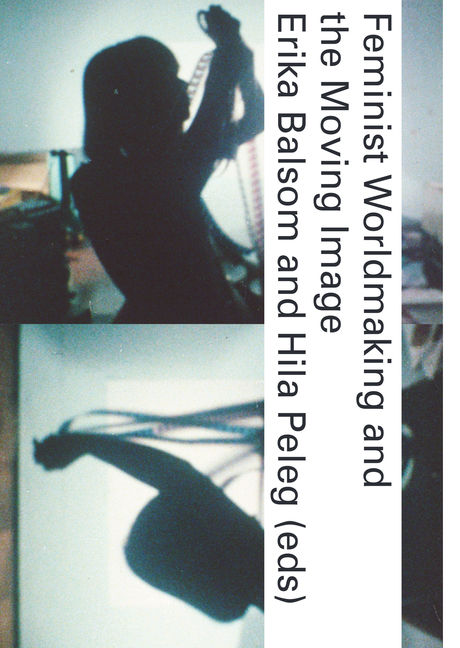
Feminist Worldmaking and the Moving Image
This book offers intersectional, intergenerational, and international perspectives on nonfiction film- and videomaking by and about women, examining practices that range from activist documentaries to avant-garde experiments. Concentrating primarily on the period between the 1970s and 1990s, the contributions revisit major figures, contexts, and debates across a polycentric, global geography. They explore how the moving image has been a crucial terrain of feminist struggle—a way of not only picturing the world but remaking it.
The contributors consider key decolonial filmmakers, including Trinh T. Minh-ha and Sarah Maldoror; explore collectively produced films with ties to women's liberation movements in different countries; and investigate the cinematic expressions of tensions and alliances between feminism and anti-imperialist struggles. They grapple with the need for a broader more inclusive definition of the term "feminism"; meditate on the figure of the grandmother; reflect on realist aesthetics; and ask what a feminist film historiography might look like.
The book, generously illustrated with film stills and other images, many in color, offers ten original texts, two conversations, and eight short essays composed in response to historical texts written by filmmakers. The historical texts, half of which are published in English for the first time, appear alongside the essays.
Contributors
Helena Amiradżibi, Madeleine Bernstorff, Teresa Castro, Counter Encounters (Laura Huertas Millán, Onyeka Igwe, Rachael Rakes), Ayanna Dozier, Forough Farrokhzad, Safi Faye, Devika Girish, Elena Gorfinkel, Haneda Sumiko, Shai Heredia, Juliet Jacques, Sarah Keller, Nzingha Kendall, Julia Lesage, Beatrice Loayza, Janaína Oliveira, Lakshmi Padmanabhan, Yasmina Price, Elizabeth Ramírez-Soto, Pooja Rangan, Lis Rhodes, Sara Saljoughi, Rasha Salti, Isabel Seguí, Chick Strand, Monika Talarczyk, Trinh T. Minh-ha, Françoise Vergès, Claudia von Alemann, Mitsuyo Wada-Marciano, Shilyh Warren, Giovanna Zapperi
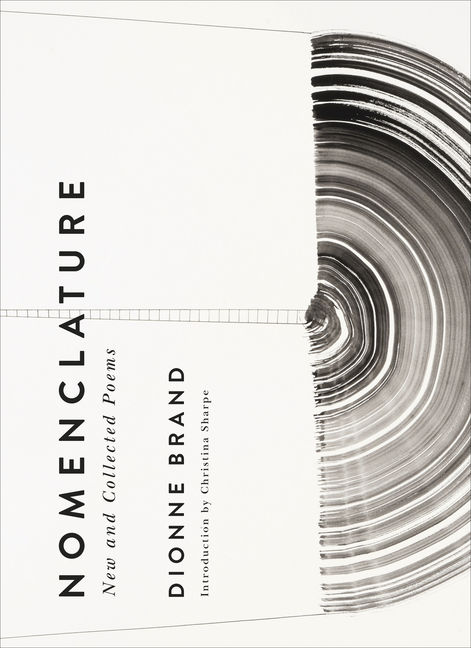
Nomenclature: New and Collected Poems
Nomenclature: New and Collected Poems collects eight volumes of Dionne Brand's poetry published between 1983 and 2010, as well as a new long poem, the titular Nomenclature for the time being.
Dionne Brand is the author of numerous volumes of fiction, poetry, and nonfiction. Her latest poetry collection, The Blue Clerk, also published by Duke University Press, was shortlisted for the Griffin Poetry Prize and won the Trillium Book Award. Her other poetry collections have won the Griffin Poetry Prize, the Governor General's Literary Award, the Trillium Book Award, and the Pat Lowther Memorial Award. Brand's novel, Theory, won the 2019 OCM Bocas Prize for Fiction and the Toronto Book Award, and What We All Long For won the Toronto Book Award. Her works of nonfiction include Bread Out of Stone and A Map to the Door of No Return: Notes to Belonging. From 2009 to 2012 Brand served as Toronto's Poet Laureate. In 2021 Brand was awarded a Windham-Campbell Prize in Fiction. She lives in Toronto.

Amanda
The artist book Amanda is greatly inspired by “Tradeswomen” quarterly magazine for women in blue-collar work, published in the 1980’s and 1990’s in the United States. Amanda is similarly thought as a periodical dealing with the subjects of technology and industry from a feminist (not solely female) angle. The first issue contains fiction stories of an emancipatory character, citing trade associations, oil industry in Iran and ghosts of the printer feeders.
The publication is made in the framework of The Building Institute, an experimental organisation aiming to strengthen the position of femmes builders in the domain of technical construction work. Amanda brings together literary texts by Maria Toumazou, Samantha McCulloch, Sepideh Karami and Madeleine Morley, combining fiction stories with visual artwork.
Olga Micińska is a visual artist currently living in Amsterdam. Graduated from the MA Art Praxis program at the Dutch Art Institute and holds an MFA in Sculpture from the Academy of Fine Arts in Warsaw. Also trained as a woodworker, collaborates with craft studios of various domains. Recently she has initiated The Building Institute.
The Building Institute (TBI) is an experimental platform aiming to emancipate the undermined knowledges dwelling in the craft domains, and to unpack diverse questions related to technology and the means of production. TBI combines art’s speculative competences with the grounded practice of manual labor, manifesting its objectives through educational activities, exhibitions, and publications.

Language is a map of failures: Messy thoughts on reading, writing and dressing up
Afternoon Editions no. 3: Language is a map of failures. Messy thoughts on reading, writing and dressing up by Runa Borch Skolseg.
In May 2019, Time has fallen asleep in the afternoon sunshine relocated its base to the Oslo Biennale headquarters in Myntgata, with a room of its own and ongoing activities. Runa Borch Skolseg visited the space at several occasions before its final closure, in 2021. Her invitation to write for the Afternoon Editions bridges the move from one room to another, and is a reflection on how fashion can be a world of fantasy, and drama, a language we all communicate through. With a personal narrative she makes readings of clothes, literature and writing, and how they merge and enrich each other.

Writing Dance
‘Human beings embody whatever they meet, and it’s all there when you work whether you want it there or not.’ Practice is like the dust that accumulates, and revisiting fragments of essays and talks on choreography Jonathan Burrows ended up embracing the haphazard and the mess, moments of unfocus and focus, harnessing them in pithy formulations and scores, adding room and punctuation and line breaks in the process so readers can hear the rhythm as he writes his dance on writing dance.
Jonathan Burrows is a choreographer, who has worked for many years in collaboration with the composer Matteo Fargion, with whom he continues to create and perform work. He is the author of A Choreographer’s Handbook (Routledge, 2010) and is currently an Associate Professor at the Centre for Dance Research, Coventry University.
Published by Varamo Press in the essay series Gestures
Graphic design by Michaël Bussaer

Afternoon Editions N°4: Certain Things
A day can be a composition not unlike an essay. Full of possibilities, full of limitations, bound by universal structures and marked by idiosyncratic desires. You go on walks. You read. You do your chores. All the while memory and other forms of imagination keep time with you. Books are strange companions; writing is a lonely thing rich with consolations.
Certain Things is a text by Claudia La Rocco, created with and through ideas such as these.
Published September 2022.
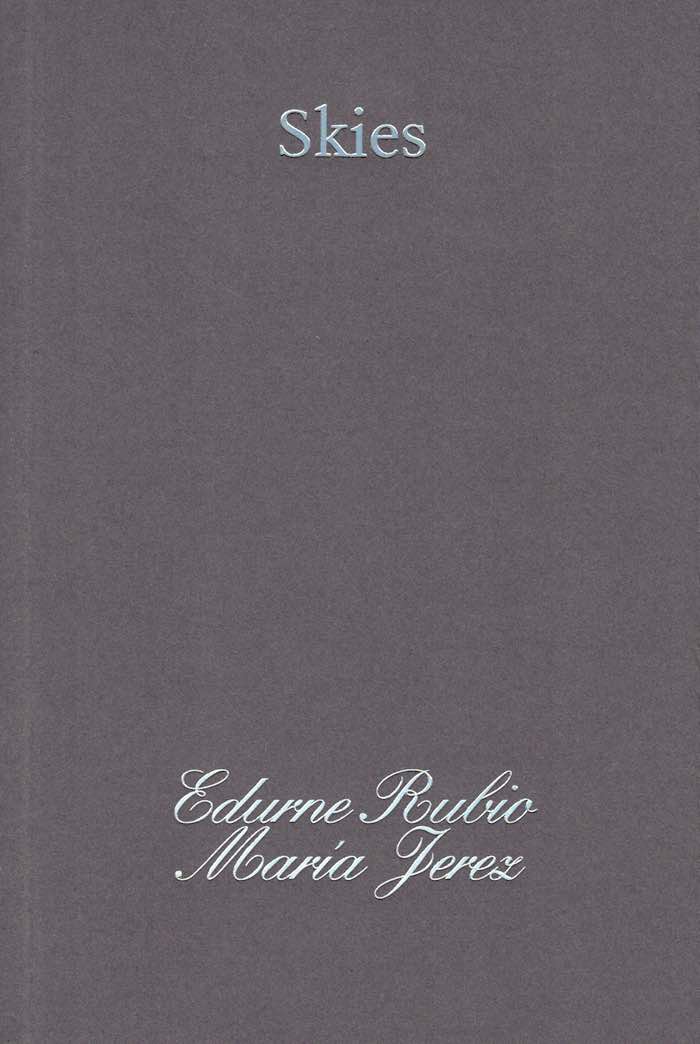
Skies
Skies is a practice that emerged when Edurne Rubio and María Jerez found themselves working in isolation during the creation process of their performance A Nublo in 2020. A dialogue in pictures capturing the skies above Madrid, Brussels and many other places, it is now a book and document of a particular time that invites others to reminisce as they read the clouds and ponder invisible worlds that haunt the aether. It comes with an essay by Augusto Corrieri on theatre and cosmos.
Edurne Rubio is a visual artist. Her work leans towards the documentary and starts out from orality and storytelling.
María Jerez creates work at the intersection of choreo graphy, film and visual art. With her work, she wants to open up spaces of possibility through the encounter with what is foreign to us.
www.edurnerubio.org
www.mariajerez.com
Published by Varamo Press in the essay series Gestures
First edition October 2022
200 pages, 11 x 16.5 cm, sewn perfect binding
ISBN: 978-82-691492-6-5
Graphic design by Michaël Bussaer